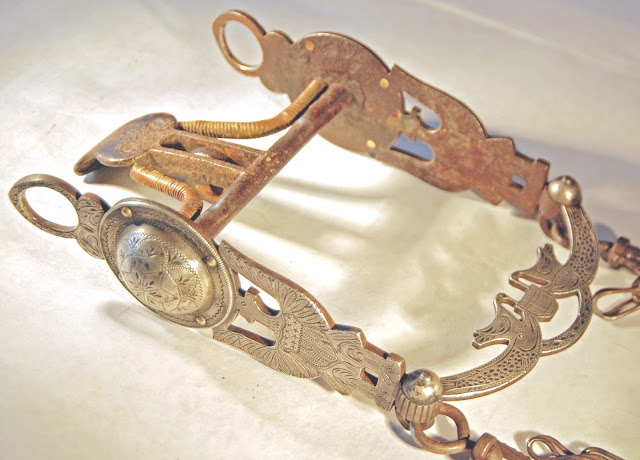G. S. Garcia, Elko Nevada
By the start of 1904, the G. S. Garcia Harness and Saddlery would be one of Elko's largest employers. The quality, craftsmanship and attention to detail was unmatched.
Concho Buckle on the Headstall, likely to have been engraved by Rafael Gutierrez between 1911 and 1916
Guadalupe S. Garcia was born in Sonora, Mexico in 1864 and was raised in Santa Margarita, near San Luis Obispo, California. In 1882, he apprenticed with the Arana Saddle Shop in San Luis Obispo, prior to opening his own shop in Santa Margarita in 1883. In 1894, G. S Garcia moved to Elko, Nevada.
The first Garcia catalog was published in 1897. The Saddlery was employing about 20 craftsmen and apprentices at that time. Alsalio Herrera was hired from Visalia, California for the post of master bit and spur maker. He brought 35 years of experience of working with his father, a famous maker in his own right.
When coupled with G. S. Garcia's natural marketing ability, there was no stopping the resulting success of the company.
 |
G. S. Garcia Number 16 Snake Spurs - Extremely Rare!
G. S. Garcia was involved in every aspect of design and implementation. By all accounts he was inspired by the elaborate and ornate styles of the early California vaqueros, many of which had their origins in Colonial Spain and Mexico.
Beginning in 1899, G. S. Garcia employed the most distinguished spur makers of the time, including Gus Goldberg, Juan Estrada, Mike Morales, Adolf Biancani, Alsalio Herrera, and Raphael (Philo) Gutierrez.
These great artists are credited with producing Garcia's finest work. Juan Estrada had been hired in 1896 to make the bits and mouthpieces. Over the next 5 years, Estrada apprenticed in silver engraving under Herrera and became one of the best.
 |
Spectacular Gus Goldberg Woolly Chaps
 |
 |
G. S. Garcia bits and spurs were marked in different ways, depending on the maker and the date made. Those pieces marked with the backward "N" were made prior to 1910.
In 1904, G. S. Garcia won the Gold Medal for his silver show saddle entered at the St. Louis World's Fair - and thereby began his vast world-wide popularity and the overwhelming success that has been continued for generations. The silver on that saddle, bridle and bit was the work of Alsalio Herrera.
 |
A great pair of Henry Garcia Spurs from the Garcia Saddlery in Salinas, California
The Old G. S. Garcia Elko Stamp, showing the inverted or "Dutch" N |
 |
Henry Garcia, son of famed G .S. Garcia, left his father's shop in Elko, Nevada in 1935 to open a branch of the family's saddlery in Salinas, California (about 100 miles south of San Francisco). The family had enough capital to establish a branch in a different area and felt that Salinas presented an opportunity to be in an area of more rapid economic recovery and higher population. Henry was only 23 years old, but was thoroughly trained in all aspects of saddle making and bit and spur crafting. The shop he rented was at 10 W. Gabilan Street.
By 1939, Garcia Saddlery was making the championship saddles for the Salinas Rodeo events. Every year for over 15 years, Henry Garcia also donated a Garcia saddle to the Rodeo. The brothers convinced their mother (Mrs. Saturnina Garcia) to leave Elko and join them in Salinas, but not until that year.
 |
Pristine Garcia, Salinas Saddle in the Acorn Pattern |
During WWII, the store closed its doors temporarily. Materials for saddle making were diverted to the wartime effort, and the US Army requisitioned the store building to use as a recruiting office. Les Garcia entered the military and made some good contacts which allowed him to arrange for a contract with the Army to provide US soldiers with leather wallets. Even mass-produced, those wallets were beautifully adorned with either the signature Garcia Acorn or Rose patterns and then hand-laced.
As soon as the Army contract was concluded and the war came to an end, Henry and Les Garcia re-opened the Garcia Saddlery and continued the family business. By 1948, they were offering their wares in a newly styled 31-page catalog filled with saddles, headstalls, bits and spurs, boots, belts and buckles, trousers, shirts and cowboy hats.




just found an old Nevada state journal book with his ad for his saddles & spurs..in elko nv,,very nice..
ReplyDeleteHow much is the Salinas Calif saddle worth? It is gorgeous!
ReplyDeleteHow much is custom made Henry Garcia acorn saddle worth?
ReplyDeleteThank You and I have a super supply: How Long Does House Renovation Take split level home kitchen remodel
ReplyDelete